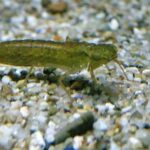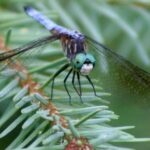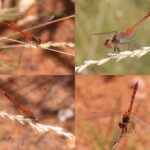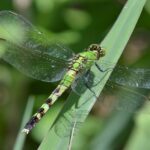A dragonfly is a member of the suborder Anisoptera and the order Odonata. Although small and delicate in appearance, it is renowned as a fierce and highly effective predator. Research has demonstrated that dragonflies rank among the most formidable and efficient hunters in the animal kingdom. The life cycle of a dragonfly begins with the hatching of an egg, from which a larva emerges. Most of the dragonfly’s lifespan is spent in the larval stage, a period rarely witnessed as these larvae reside beneath the water in ponds and lakes.

Description
Dragonfly nymphs exhibit various morphological forms, classified as Sprawlers, Claspers, Burrowers, and Hiders. The initial stage of development, known as the Prolarva, is relatively inert. From this stage, the nymphs swiftly transition into the active Nymphal phase. The body structure of the larvae closely resembles that of the adult dragonfly, with the notable exception that larvae lack wings and reproductive organs. Prey is captured using the extensible labium, an appendage of the lower jaw armed with spines and hooks. Typically resting in a folded position under the body, the labium is rapidly thrust outward by the hydraulic pressure generated by the abdominal muscles. Dragonfly nymphs possess internal gills, located near the fourth and fifth abdominal segments.
Habitat
Dragonfly larvae are aquatic and inhabit rivers, streams, lakes, ponds, and wetlands. They favor areas where the water is calm or gently flowing, often clinging to the submerged surfaces of rocks or wood.
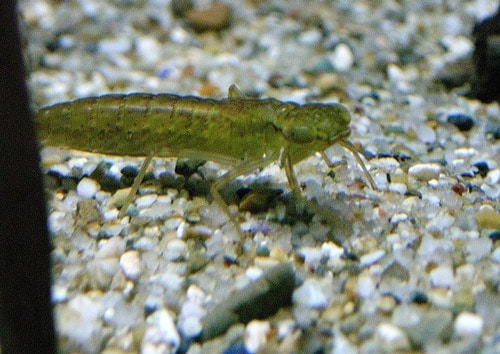
Lifecycle
An adult dragonfly can produce a clutch of approximately 1,500 eggs, which hatch after about seven days, evolving into aquatic nymphs. The larval stage can last anywhere from two months to three years in smaller species, and up to five years in larger varieties. During this period, the larvae feed on tadpoles, small fish, and mosquito larvae using their toothed labium. Respiration occurs through gills located in the rectum. Larvae undergo 6 to 15 molts during their developmental stages. As the larva nears metamorphosis into an adult, it ceases feeding and rises to the water’s surface, usually at night. At this point, its respiratory organs begin to transition to air-breathing. The head of the larva emerges from the water, and it climbs onto an emergent plant or reed. There, it anchors itself using its claws and begins to molt. As the skin behind the head splits, the larval stage concludes, and the adult dragonfly emerges.
Diet
Dragonfly larvae are voracious predators, preying on small insects, mosquito larvae, and small crustaceans. Early in their development, they lie in wait for passing prey, capturing it with their labium. As they grow larger, they expand their diet to include tadpoles and small fish.
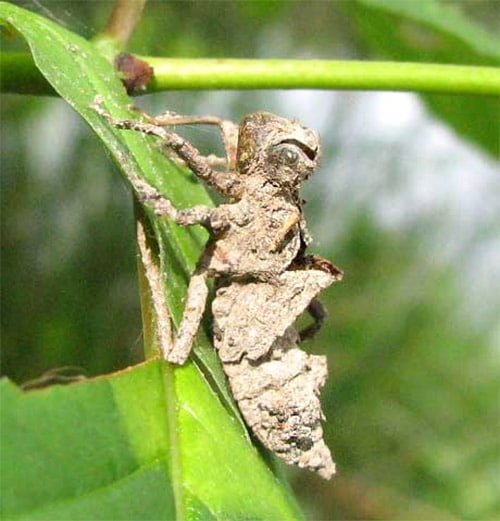
Infections
Small dragonfly larvae are particularly vulnerable to water mites, known as Hydracarina, which can prove fatal. Protozoa, such as Gregarines, infect the gut, causing secondary infections and blockages. Additionally, Cercariae, the larval stage of the Trematodes parasite, may be consumed by dragonfly larvae. These parasites penetrate the larvae’s body wall, migrating to the gut where they form cysts, known as Metacercariae. These cysts remain within the larvae until the end of its life.
Dragonfly Larvae
Dragonflies inhabit a wide array of aquatic environments, including streams, wetlands, and lakes. While we often witness the dazzling flight of adult dragonflies, with their iridescent wings and vivid bodies darting above the water, the true life of a dragonfly begins beneath the surface. There, on submerged rocks, plants, and in the mud, its larvae thrive. Remarkably, dragonflies spend the majority of their lives in the larval stage, using these aquatic habitats as crucial developmental grounds. During this phase, they serve as valuable bioindicators of mercury contamination within the ecosystem.
The Dragonfly Mercury Project (DMP) employs dragonfly larvae as bioindicators to monitor mercury levels in the environment. What attributes make these larvae exceptional bioindicators?
Key Characteristics of Dragonfly Larvae:
- Predators at the Top of the Food Chain: Dragonfly larvae consume a variety of smaller insects and even small fish, placing them high on the food chain. With each predator that preys upon contaminated larvae, mercury compounds accumulate, amplifying the toxin’s spread through the food web.
- Prey for Other Species: Serving as sustenance for many fish and bird species, dragonfly larvae contribute to a cascading chain of mercury accumulation. As these predators are consumed by other animals, the toxin progresses through the ecosystem, potentially reaching humans at the top of the food chain.
- Ease of Collection and Analysis: Dragonfly larvae are relatively simple to catch with a net and easy to identify, making them an excellent candidate for ecological monitoring. Unlike fish, which can be more challenging to sample, larvae are smaller and more manageable, encouraging volunteer involvement in the research.
- Diverse Habitat Occupants: Dragonfly larvae inhabit a broad range of aquatic environments, including those where fish may not reside. They are found on every continent except Antarctica, ensuring that they provide a widespread reflection of environmental conditions.
- Surrogate Species for Freshwater Life: The mercury concentrations found in dragonfly larvae are often analogous to those observed in other freshwater organisms, such as fish and amphibians, offering a reliable gauge of contamination levels across species.
As integral components of the aquatic food web, dragonfly larvae occupy dual roles as both predators and prey. Their elevated mercury levels, compared to other aquatic insects, underscore their importance in tracking contamination. These larvae, as prey for fish and birds, contribute to the onward transmission of mercury contamination, with potential risks extending to humans through the consumption of contaminated fish. By analyzing mercury levels in dragonfly larvae and comparing them to established toxicity thresholds, researchers can assess the potential health risks to humans and wildlife alike.
Family
There are eight families of dragonflies within the order Odonata in North America, encompassing both dragonflies and damselflies.
Description
Dragonfly larvae (nymphs) are aquatic and generally appear unremarkable, with six legs, large eyes, and small wing buds on their thoraxes. Their gills are housed inside the rectum, as opposed to damselflies, whose gills extend like three leaf-like tails. Dragonfly larvae breathe by drawing water in and expelling it forcefully, propelling themselves through the water in a form of jet propulsion. Their lower jaws are scoop-shaped and cover most of the head’s underside.
Adult dragonflies possess slender, elongated abdomens, robust bodies, and two pairs of horizontally outstretched wings, which are intricately veined. The hindwings are broader at the base than the forewings. Their compound eyes, large and nearly covering the head, are among their most distinguishing features. Short antennae and six legs adapted for perching complete their anatomical profile.
Key Identifiers for Dragonfly Larvae:
- Elongated or robust aquatic body, typically constricted at the front of a widened abdomen; usually dull in coloration.
- Six long, jointed legs, each equipped with two claws.
- Large, prominent eyes.
- Small wing buds located on the back of the thorax.
- Rounded or oval abdomen, segmented, often marked by five wedge-shaped or pointed structures at the hind end.
- Scoop-like lower jaw, covering the majority of the head’s underside.
- Absence of external feathery gills.
Other Common Names:
- Dragonfly Nymphs
Size
- Larval length ranges from ¼ to 2½ inches, depending on the species and developmental stage.
Diet
Dragonfly nymphs are ambush predators, lying in wait on the substrate or submerged plants. When prey such as small aquatic animals or even the claw of a similarly-sized crayfish passes within reach, the nymph extends its jaws rapidly to capture and ingest the meal. Adult dragonflies employ a similar hunting strategy, using their legs in a basket-like shape to snatch small flying insects mid-flight.
Life Cycle
Male dragonflies typically perch on branches or other structures, patrolling their territories, fending off rival males, and attempting to mate with females. Mating pairs often fly in tandem, with the female flying low over the water to deposit her eggs on the surface. The larvae, or nymphs, undergo several molts during their growth, which can span several years. Once fully matured, they crawl out of the water to a safe location, shed their skin, and emerge as young adults. The final stages of maturation are completed within days or weeks.
Human Connections
For those who find mosquitoes bothersome, dragonflies are a welcome sight! They are admired not only for their beauty but also for their ecological role. It is important to note that dragonflies are harmless; while larger species may deliver a pinch if handled, they are incapable of stinging or causing harm to humans.
Ecosystem Connections
The majority of a dragonfly’s life is spent as a nymph. In some species, this stage lasts up to five years. Both larvae and adult dragonflies play crucial roles as predators of mosquitoes, midges, and other small insects. Their larvae are a vital food source for fish, frogs, and other aquatic insectivores, forming an essential link in the food chain.

